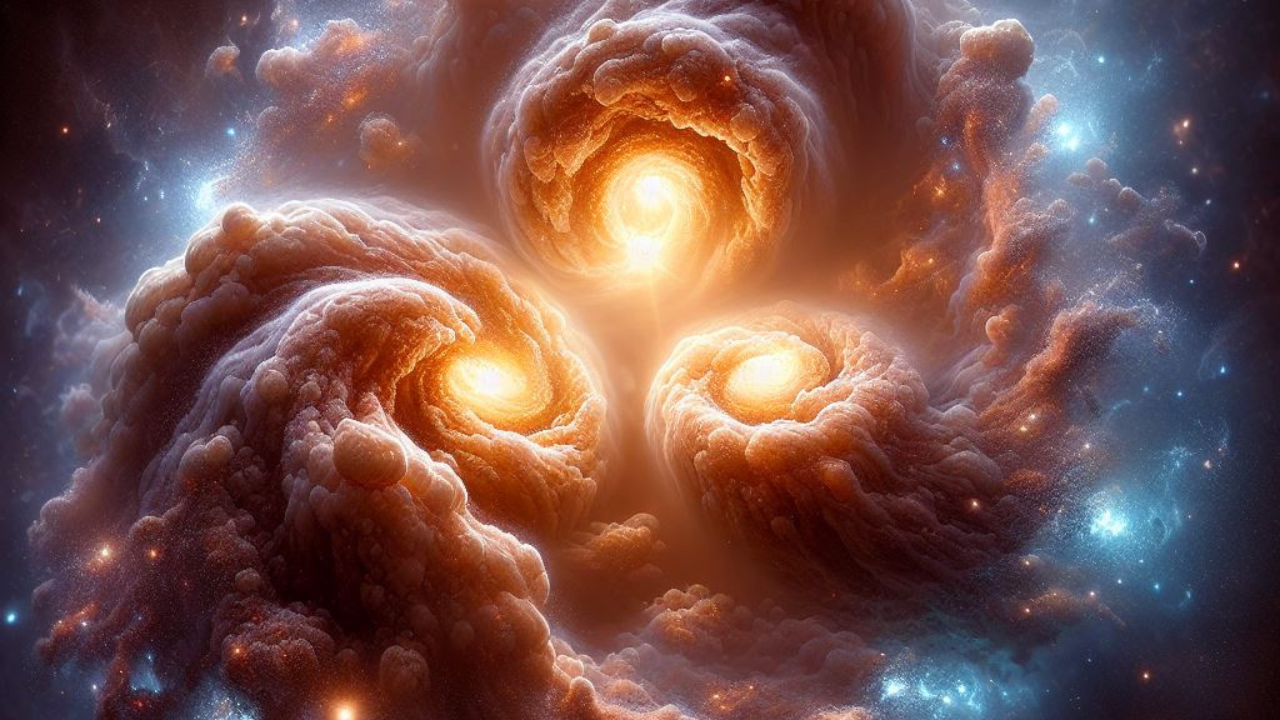NEW DELHI: For the first time, astronomers using the James Webb Space Telescope (JWST) have detected what appear to be some of the earliest galaxies in the known universe as they are being born. In a groundbreaking study published in the journal Science, researchers reported the discovery of three infant galaxies forming from a primordial cloud of hydrogen and helium gas, just 400 to 600 million years after the Big Bang.
A window into the era of reionization
This discovery provides a unique glimpse into the era of reionization, a period when the first stars and galaxies began to emerge from dense clouds of gas, transforming the opaque universe into the transparent cosmos we know today. Lead study author Kasper Heintz, an assistant professor of astrophysics at the Cosmic Dawn Center (DAWN) at the University of Copenhagen, described these galaxies as “sparkling islands in a sea of otherwise neutral, opaque gas.”
Heintz emphasized the importance of the JWST in making these observations possible. “Without Webb, we would not be able to observe these very early galaxies, let alone learn so much about their formation,” he stated in a Nasa release.
Detecting the birth of galaxies
The researchers used the JWST to examine 12 known early galaxies that date back no more than 600 million years after the Big Bang, when the universe was approximately 3% of its current age. They specifically looked for galaxies where radiation was absorbed by dense clouds of electrically neutral hydrogen gas. This absorption indicates that the galaxies were actively incorporating the gas into new stars.
By analyzing the spectra, or light wavelengths, emitted by these ancient galaxies, the team found evidence of light absorption by large amounts of neutral hydrogen gas in three of them. “This suggests that we are seeing the assembly of neutral hydrogen gas into galaxies,” said study co-author Darach Watson, also of DAWN. “That gas will go on to cool, clump, and form new stars.”
Implications for understanding the early universe
The formation of these early stars was crucial for ending the cosmic dark ages and ushering in the era of reionization. As stars and galaxies emerged from the dense gas clouds, their stellar radiation ionized the surrounding gas, transforming space from an opaque hydrogen soup into the clear, transparent cosmos observed today.
While the JWST has previously spotted ancient galaxies from this era, this is the first time astronomers have witnessed their very birth and the construction of the first star systems in the universe. “We are witnessing the assembly of the very first galaxies and star systems,” Heintz noted in a University of Copenhagen statement.
If confirmed with follow-up observations, these findings could help astronomers answer crucial questions about the nature of the gas clouds that once obscured the universe and how the first galaxies emerged to illuminate them. This groundbreaking discovery by the JWST marks a significant milestone in our understanding of the universe’s early history and the formation of its first galaxies.
A window into the era of reionization
This discovery provides a unique glimpse into the era of reionization, a period when the first stars and galaxies began to emerge from dense clouds of gas, transforming the opaque universe into the transparent cosmos we know today. Lead study author Kasper Heintz, an assistant professor of astrophysics at the Cosmic Dawn Center (DAWN) at the University of Copenhagen, described these galaxies as “sparkling islands in a sea of otherwise neutral, opaque gas.”
Heintz emphasized the importance of the JWST in making these observations possible. “Without Webb, we would not be able to observe these very early galaxies, let alone learn so much about their formation,” he stated in a Nasa release.
Detecting the birth of galaxies
The researchers used the JWST to examine 12 known early galaxies that date back no more than 600 million years after the Big Bang, when the universe was approximately 3% of its current age. They specifically looked for galaxies where radiation was absorbed by dense clouds of electrically neutral hydrogen gas. This absorption indicates that the galaxies were actively incorporating the gas into new stars.
By analyzing the spectra, or light wavelengths, emitted by these ancient galaxies, the team found evidence of light absorption by large amounts of neutral hydrogen gas in three of them. “This suggests that we are seeing the assembly of neutral hydrogen gas into galaxies,” said study co-author Darach Watson, also of DAWN. “That gas will go on to cool, clump, and form new stars.”
Implications for understanding the early universe
The formation of these early stars was crucial for ending the cosmic dark ages and ushering in the era of reionization. As stars and galaxies emerged from the dense gas clouds, their stellar radiation ionized the surrounding gas, transforming space from an opaque hydrogen soup into the clear, transparent cosmos observed today.
While the JWST has previously spotted ancient galaxies from this era, this is the first time astronomers have witnessed their very birth and the construction of the first star systems in the universe. “We are witnessing the assembly of the very first galaxies and star systems,” Heintz noted in a University of Copenhagen statement.
If confirmed with follow-up observations, these findings could help astronomers answer crucial questions about the nature of the gas clouds that once obscured the universe and how the first galaxies emerged to illuminate them. This groundbreaking discovery by the JWST marks a significant milestone in our understanding of the universe’s early history and the formation of its first galaxies.

